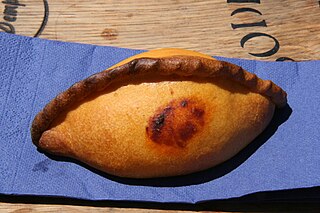Related Research Articles

La Paz, officially known as Nuestra Señora de La Paz, also named Chuqi Yapu (Chuquiago) in Aymara, is the seat of government of the Plurinational State of Bolivia. With an estimated 816,044 residents as of 2020, La Paz is the third-most populous city in Bolivia. Its metropolitan area, which is formed by La Paz, El Alto, Achocalla, Viacha, and Mecapaca makes up the second most populous urban area in Bolivia, with a population of 2.0 million, after Santa Cruz de la Sierra with a population of 2.3 million. It is also the capital of the La Paz Department.

The Ekeko is the Tiwanakan god of abundance and prosperity in the mythology and folklore of the people from the Peruvian and Bolivian Altiplano Its chief importance in popular culture is as the main figure of the annual Alasitas fair, a cultural event that happens every January 24 in La Paz, Bolivia. The Ekeko is a traditional god of luck and prosperity, popular in all the occident territory of Bolivia. In Peru the main festival is celebrated on May 3 of every year in the city of Puno, on the Machallata hill.

Sancti Spíritus is a municipality and capital city of the province of Sancti Spíritus in central Cuba and one of the oldest Cuban European settlements. Sancti Spíritus is the genitive case of Latin Sanctus Spiritus.

El Alto is the second-largest city in Bolivia, located adjacent to La Paz in Pedro Domingo Murillo Province on the Altiplano highlands. El Alto is today one of Bolivia's fastest-growing urban centers, with an estimated population of 943,558 in 2020. It is also the highest major city in the world, with an average elevation of 4,000 m (13,123 ft).
Carlos Enrique Polanco is a notable exponent of Peruvian painting. Since his beginnings he was attracted to the less privileged urban sectors of Lima City. When he studied in School of Fine Arts, his work reflected the iconography and color of the Peruvian urban night life. Polanco is an artist with a social commitment.

The Central Bank of Bolivia is the central bank of Bolivia, responsible for monetary policy and the issuance of banknotes. The current president of the BCB is Pablo Ramos Sánchez.

Gonzalo Morales Sáurez was a Costa Rican painter. He studied in The San Fernando Academy in Madrid, Spain from 1970 to 1974. He is best known for his hyper-realistic works, and has exhibited his art in many museums and art galleries in Europe and the Americas.

A salteña is a type of baked empanada from Bolivia.
Antonio Paredes Candia was one of the most prolific writers and researchers of Bolivia with over 100 books written during his lifetime. All of the books were written and published without any grants or financial aid from the government. He is considered an icon of the Bolivian culture and identity. His work focuses mainly on Bolivian folklore, primarily focusing on the country's traditions, characters, customs and superstitions.
Camba is a word historically used in Bolivia to refer to the indigenous population in the eastern tropical region of the country, or to those born in the area of Santa Cruz, Beni, and Pando. Nowadays, the term "Camba" is used predominantly to refer to eastern Bolivian populations of mixed Spanish, Chane, and other indigenous Amazonian descent born in the eastern lowlands in and around Santa Cruz de la Sierra.

The Museo de Arte Antonio Paredes Candia is an art museum in El Alto, Bolivia.

The Art Museum of Antonio Paredes Candia is an art museum located in El Alto, Bolivia. It holds more than 500 works and 11000 books.
The Supreme Court of Justice is the highest court of ordinary jurisdiction in Bolivia, based in Sucre. Its powers are set out in Articles 181–185 of the 2009 Constitution and the Law of the Judicial Organ. It was first seated on 2 January 2012.
Condarco is a surname. Notable people with the surname include:

Mauricio García Vega is a Mexican painter whose work has been recognized by various awards and membership in the Salón de la Plástica Mexicana. His work is mostly focus on urban landscapes often with dark themes and a chaotic feel. He works alone and with his brother Antonio García Vega. He lives and works in the Mexico City suburb of Ciudad Nezahualcóyotl.

Josep Collell was a Catalan painter and ceramicist who lived in Montevideo from 1950, where he developed his artistic career. He was a member of the Taller Torres-Garcia and in 1955 he created, together with his wife Carmen Cano, the Taller Collell of ceramics where for thirty years they taught their ceramic technique, the burnished engobe.
Elsa Paredes de Salazar was a Bolivian researcher and multifaceted journalist, promoter of women's organizations, and doll collector.
Cecilia Paredes is a Peruvian-born multimedia artist residing in Philadelphia. Her primary themes include the power of nature, femininity, and migration, which have been subjects of many of her shows. She frequently utilizes natural elements, often recycled waste materials and primarily organic ones, in her installations. One of her best-known works is "Paisajes" in which she camouflages herself and uses her own figure as a canvas for body painting.
The Chapare Drug Cartel is a Bolivian criminal organization dedicated to drug trafficking and human trafficking that operates in the Chapare region. For this, several journalists have baptized this organization simply as the Chapare Cartel
References
- ↑ "LITOMORFOSIS - ESCULTURAS GONZALO CONDARCO" (in Spanish). Museo Nacional del Arte. Retrieved 26 June 2011.
- ↑ "Museo Antonio Paredes Candia es referente cultural" (in Spanish). Eldiario. Archived from the original on 24 December 2011. Retrieved 26 June 2011.